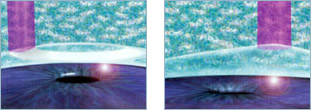Why is Epi-LASIK better and safer than LASIK?

Epi-LASIK is a refractive procedure that treats the same refractive changes as LASIK. Both procedures treat nearsightedness (myopia), far-sightedness (hyperopia) and astigmatism. Epi-LASIK is actually a refinement of the original refractive procedure (PRK) that started the entire laser surgical refractive movement.
Epi-LASIK is considered to be a safer procedure than LASIK. Although flap complications with LASIK are relatively low, they can cause irreversible vision loss and results that are less than optimal. With Epi-LASIK the superficial epithelial flap completely regenerates and, at the same time, preserves the structural integrity of the eye.
In Epi-LASIK the superficial epithelium is separated from the underlying corneal tissue with a blunt separator. This separator does not cut into the deeper layers (stroma) of the cornea. After this superficial epithelium is lifted or removed the laser is performed on top of the stroma. The epithelium then heals over naturally. The structural integrity of the cornea is never compromised. (see attached drawing)
In LASIK, a flap is created whereby a blade cuts into the stroma, through the epithelium. The laser is performed in the stroma and the flap created is placed back into place. The problem here is that the strongest part of the cornea is split and thus its integrity is violated. From a practical standpoint the cornea heals but never back to its original strength. Additionally, because this flap never heals 100% it is subject to dislocation, (rare, but it does happen especially with trauma) thinning and bulging (ectasia) as time moves on.
I have always placed safety as the number one issue concerning ocular laser surgery. This is the reason why I strongly endorse Epi-LASIK for my patients instead of LASIK.
|
Epi- LASIK advantages
|
LASIK Advantages
|
|
|
|
Epi-LASIK Disadvantages
|
LASIK Disadvantages
|
|
|
| Some of these are not proven but are based on theory, multi-center studies and individual ophthalmologist’s opinions who have performed Epi-LASIK. | |


